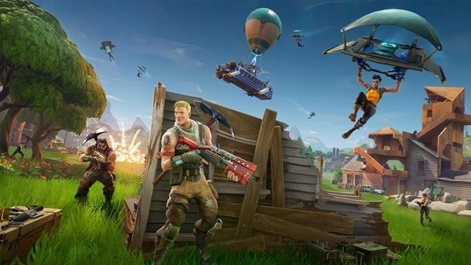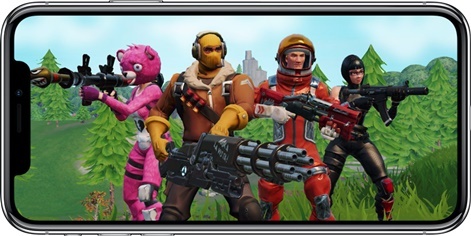You may have heard of a little game called Fortnite. It's become a cultural phenomenon since Epic Games launched the 100-player PvP battle royale mode last year.
Originally conceived as a PvE co-operative survival shooter where players would fortify an area to defend against the oncoming horde of enemies, the title was first announced back in 2011. It wasn’t released until 2017, with battle royale coming later.
Epic is best known for its console triple-A experiences, though it does have experience in mobile with Chair Entertainment’s Infinity Blade series. Fortnite was unquestionably built as one of those high-end, slick triple-A games.
And yet, in March 2018 the full Fortnite Battle Royale experience was announced for mobile and released on the App Store. The port is all thanks to the work put into Unreal Engine and Apple’s Metal API.
Lucky Landing
“The use case of Fortnite was really interesting because it was a game that has been in development for a super long time,” Epic Games’ Arjan Brussee tells PocketGamer.biz. The developer moved to Epic late last year following his departure from the now defunct Boss Key Productions, which he co-founded with Cliff Bleszinski, who worked on Fortnite before forming Boss Key.
“Fortnite was never really set up to be a mobile game, or a Nintendo Switch game for that matter. Being able to push it on all these devices relatively quickly, and still keeping it the same game, that's the thing that we're internally proud about. This is quite amazing.”

Being both a triple-A games development and game engine provider - one that in recent years in particular has focused on opening up its technology to the masses - the work Epic has put into Fortnite has also gone into developing Unreal Engine.
That means new features powering opportunities for games that can be played across PC, console and mobile, while keeping the same experience, are being opened up to Unreal Engine developers in the latest 4.20 update, released today.
“We want to make this, from an engine point of view, a lot easier for people to support all these awesome different platforms,” says Brussee.
“The ultimate idea would be just press a button and it'll work, you know, which is kind of crazy, and obviously we're not there yet.”
We want to make this, from an engine point of view, a lot easier for people to support all these awesome different platform.Arjan Brussee
While Fortnite is available on the App Store, it’s currently notably absent from Android devices. Brussee says that as the operating system has such a diverse ecosystem with no single OEM, the fragmentation means it’s harder to develop cross-play technology like it's done with Metal on iOS.
Despite this though, improvements to Android support are expected. As is a Fortnite Android release, which is expected in the summer.
Pleasant Park
One key feature in Unreal Engine 4.20 is the new proxy LOD system, the development of which has been driven by work on Fortnite.
The team needed to make sure the mobile experience worked as well as its counterparts, including down to a similar draw distance - a difficult proposition on a large, destructible map with 100 players battling it out.
“We spent a lot of time making content more optimised and trying to automate that,” explains Brussee.
“We can basically take the content we're making for any other platform, like PC and console, and almost automatically bake it down into simplified and much more optimised ways to draw it.
“Our specific challenge as well was Fortnite has destructibility. So many games out there do not feature destructibility at all, even console games, to the crazy effect that Fortnite has.
“So we had to make a system that works with destructibility in that same vein. We can make super low LODs for far away. They look terrible if you look at it up close, but far away where pixels or so distant, then you cannot tell it apart at all.”

A host of other improvements to the engine and for mobile have been included with Unreal Engine 4.20 to make it easier for developers to optimise and ship.
There are more than 100 optimisations for mobile that have been made, including improved Android debugging, mobile Landscape improvements, RHI thread on Android and occlusion queries.
We've been leading 3D game development and graphics for years and I think we now enable that on mobile.Arjan Brussee
Brussee says that goes right down to ensuring that, when supporting high-end games on powerful mobile chips, they also don’t drain the battery or overheat the device.
“Everything we could optimise out of there, we did,” says Brussee. “The great thing is our engine guys who were working on Fortnite Mobile immediately brought it back to the engine.
“So basically everything that we shipped for the mobile version is in 4.20. All those optimisations. And there's many of them, from audio to physics to particles to materials. There's a lot of stuff in there.”
By powering these 3D game experiences, Epic appears to be doubling down on the high-end as its core focus for Unreal Engine, rather than moving the other way for trendy hyper-casual and the instant gaming experiences seen in chat apps like Facebook Messenger.
And Brussee says it’s those 3D high-end games that Epic sees the market moving toward. As well as powering the $1 billion Fortnite IP, it’s also been used to power other hugely popular games in Asia such as Lineage M and Lineage 2: Revolution - both titles that have generated hundreds of millions of dollars in a short space of time.
“I feel like now we're transitioning from 2D games to heavier 3D games,” says Brussee of the mobile market.
“I think we are very well positioned for that. We've been leading 3D game development and graphics for years and I think we now enable that on mobile. So on the 2D games maybe we weren't as strong, but on 3D games we sure are.
“I think there's a lot of opportunity for us in that space.”





















